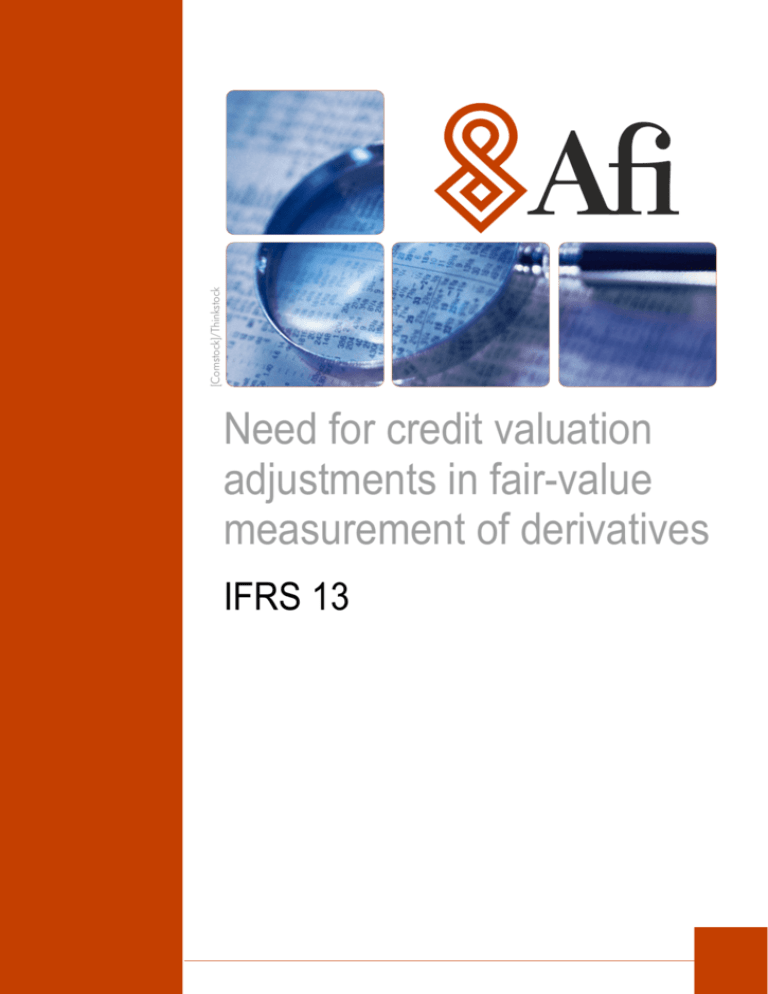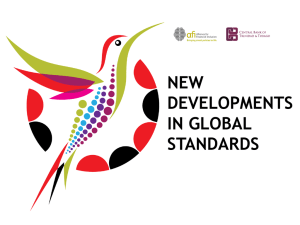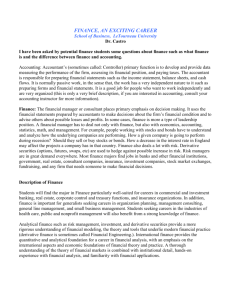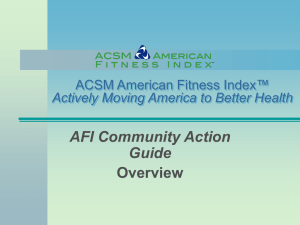Need for credit valuation adjustments in fair-value measurement
advertisement

[Comstock]/Thinkstock Need for credit valuation adjustments in fair-value measurement of derivatives IFRS 13 Need for credit valuation adjustments in fair-value measurement of derivatives IFRS 13 The recent financial crisis has highlighted the importance of correctly assessing credit risk and prompted regulators and supervisors to introduce fresh requirements in terms of presenting certain transaction for accounting purposes. www.afi.es Analistas Financieros Internacionales (Afi) is a benchmark provider or risk assessment and measurement services to banks and corporates in Spain. Afi is in a position to measure, in its capacity as independent expert, credit valuation adjustments (for counterparty risk, CVA, or proprietary risk, DVA) in determining the fair value of financial instruments, including derivative portfolios, that will be mandatory under accounting regulations from 1 January 2013. Applicable regulations Before IFRS 13 took effect on 1 January 2013, there was no clear guidance on how to measure credit risk even though, in theory, it had to be factored into fair value measurements. The IFRS 13 accounting treatment became mandatory by means of the passage of Commission Regulation (EU) No 1255/2012 of 11 December 2012, published in the Official Journal of the European Union on 29 December 2012. IAS 39 states that the fair value of financial instruments should factor in the associated credit risk without specifying how this should be done in the case of derivatives (where credit risk is bi-directional). In practice, under the outgoing regime, some companies accounted for their own credit risk while others did not. IFRS 13 clarifies many aspects related to credit risk. In brief: 4 It is effective for annual periods beginning on or after 1 January 2013. 4 It has been transposed into Community regulations, which means that it affects the consolidated financial statements of listed entities and other entities that voluntarily prepare their consolidated financial statements under IFRS. 4 It not only affects financial instruments but also all items that must be measured at fair value: assets, liabilities and equity instruments. 4 An entity’s own credit risk must be factored into fair value measurement. 4 Subject to compliance with certain requirements, credit risk of groups of financial Methodology and processes These regulatory changes imply not only the need to incorporate complex methodologies but also the use of IT systems to support these methodologies and all the necessary information. 4 In the case of a derivative instrument that may imply future cash inflows or outflows (e.g. swaps and forwards), the incorporation of a simple credit spread for the counterparty into the rate used to discount the future cash inflows and an own credit spread to discount cash outflows is not correct. Counterparty credit risk is only of 2 Need for credit valuation adjustments in fair-value measurement of derivatives IFRS 13 4 In the case of derivatives with a master agreement that contemplates position netting, the above calculation has to be performed in an integrated manner for all the derivatives included in a given netting set. 4 Accordingly, the process requires the performance of the following tasks: Ÿ The upload into a database of the intrinsic characteristics of the group of derivatives as well as information on the reporting entity and the counterparty. Ÿ The generation of scenarios for the underlying market variables for the group of derivatives in each netting set using Monte Carlo methodology calibrated for market data and using correlations. Ÿ Estimated credit spreads and loss given default (LGD) for the counterparty banks and entities (implicit in market data or in-house estimates in the event there is no liquid market for the instruments for the purpose of calculating these values implicitly). Ÿ The generation of times to default for each company and counterparty for each of the scenarios defined in the Monte Carlo modelling process for the key market variables. Ÿ The aggregation of the results and the calculation of risk-free valuations and value at risk to obtain the amount of credit valuation adjustments for each netting set and, lastly, the allocation of this aggregate amount to each individual derivative. 3.50 Exposure to counterparty risk 3.00 Value of portfolio without CVA: €0.79mn Credit valuation adjustment (CVA): €0.19mn Value of portfolio with CVA: €0.6mn 2.50 € (mn) www.afi.es significance when the net amount of future cash outflows and inflows positive for the reporting entity, while own credit risk is only of relevance when the net amount of cash outflows and inflows yields a negative fair value (for the reporting entity). Nor is it correct to use these spreads as a function of the estimated net amount of future cash flows. Simulation techniques are required to factor in the impact of both classes of credit risk. 2.00 1.50 1.00 0.50 0.00 0 1 2 3 4 5 6 7 8 9 10 11 12 Tiempos Time (years) (Años) 3 Need for credit valuation adjustments in fair-value measurement of derivatives IFRS 13 Service www.afi.es Afi is recognised as having the skills needed to perform this work. Its Quantitative Finance team boasts experience dating back over 20 years valuing and measuring risk deriving from derivative and structured products. It passes this know-how on by training in-house teams to perform these tasks as well as carrying out valuation work of this kind directly for banks, insurers, asset managers and corporates, providing external and independent risk valuations and measurements of the highest standing vis-à-vis auditors and regulatory supervisors. This service can be tailored and articulated around one or more of the following components: 4 Initial and periodic valuation service: providing transparency in terms of the methodology and inputs used, the end result is the credit valuation adjustment required for the entity’s derivative portfolios. 4 Back-up materials to support the approach taken vis-à-vis auditors: Afi is willing to meet with management and directly with auditors if required to explain the approach taken and answer any questions that may arise. This support may be particularly valuable in light of the technical complexity of the quantitative analysis and the first-time application of this accounting treatment. 4 Web-access or onsite implementation of Afi’s proprietary modelling tools (the AfiVal web-based valuation system) 4 Support for the development of credit valuation adjustment applications for layering into an entity’s existing IT systems, helping to define the process and/or providing the specific end codes or models in Excel or Matlab that can be of valuable assistance in the process of developing the corresponding modules internally. 4 The audit or cross-checking of third-party tools already installed or of software developed in-house. 4 Advice on testing hedges for effectiveness for hedge accounting purposes. Contact For any additional information or queries, please contact: Contact: E-mail: Tel: Ángel Moreno | Pablo Guijarro amoreno@afi.es | pguijarro@afi.es 915 200 108 | 915 200 435 Website: www.afi.es Address: Españoleto, 19 - 28010 Madrid 4






